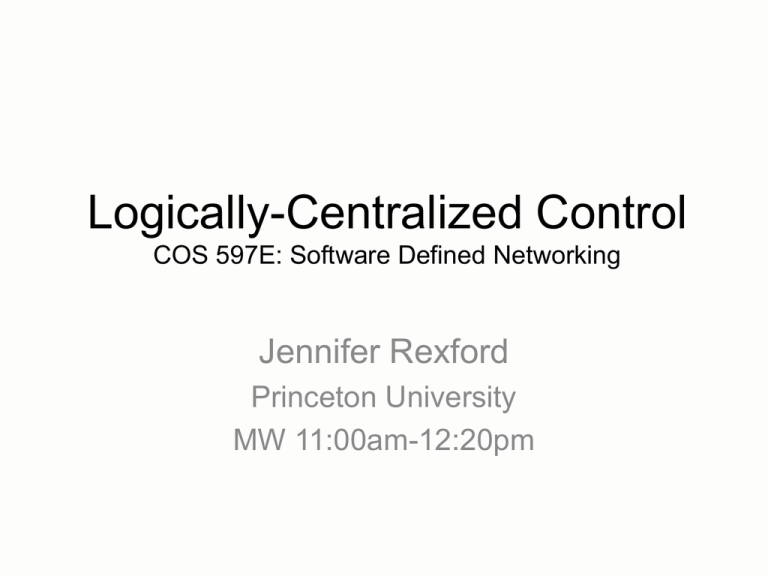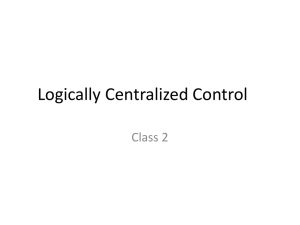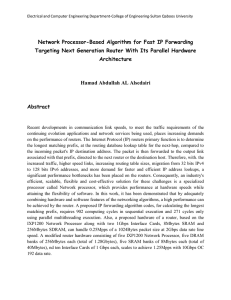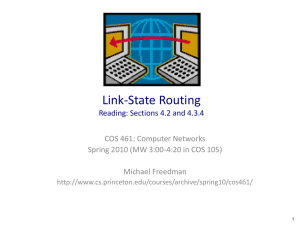Logically-Centralized Control
advertisement

Logically-Centralized Control
COS 597E: Software Defined Networking
Jennifer Rexford
Princeton University
MW 11:00am-12:20pm
Software Defined Networking
2
Control/Data Separation
decouple control and data planes
by providing open standard API
3
(Logically) Centralized Controller
Controller Platform
4
Protocols Applications
Controller Application
Controller Platform
5
Data, Control, and
Management Planes
6
Timescales
Data
Timescale
Tasks
Packet
(nsec)
Forwarding,
buffering,
filtering,
scheduling
Location Line-card
hardware
Control
Management
Event (10
Human (min
msec to sec) to hours)
Routing,
circuit
set-up
Analysis,
configuration
Router
software
Humans or
scripts
7
Data and Control Planes
control plane
data plane
Processor
Line card
Line card
Line card
Line card
Switching
Fabric
Line card
Line card
8
Data Plane
• Streaming algorithms on packets
– Matching on some bits
– Perform some actions
• Wide range of functionality
–
–
–
–
–
–
–
Forwarding
Access control
Mapping header fields
Traffic monitoring
Buffering and marking
Shaping and scheduling
Deep packet inspection
Processor
Switching
Fabric
9
Switch: Match on Destination MAC
• MAC addresses are location independent
– Assigned by the vendor of the interface card
– Cannot be aggregated across hosts in LAN
mac1
mac2
host
host
mac3
...
host
mac1
mac2
host
switch
mac3
mac4
mac5
host
mac5
mac4
10
Router: Match on IP Prefix
• IP addresses grouped into common subnets
– Allocated by ICANN, regional registries, ISPs,
and within individual organizations
– Variable-length prefix identified by a mask length
1.2.3.4 1.2.3.7 1.2.3.156
host
host
...
5.6.7.8 5.6.7.9
host
host
host
5.6.7.212
...
host
LAN 2
LAN 1
router
WAN
1.2.3.0/24
5.6.7.0/24
forwarding table
router
WAN
router
Prefixes may be nested.
Routers identify the
longest matching prefix.
11
Forwarding vs. Routing
• Forwarding: data plane
– Directing a data packet to an outgoing link
– Individual router using a forwarding table
• Routing: control plane
– Computing paths the packets will follow
– Routers talking amongst themselves
– Individual router creating a forwarding table
12
Example: Shortest-Path Routing
• Compute: path costs to all nodes
– From a source u to all other nodes
– Cost of the path through each link
– Next hop along least-cost path to s
v
3
u
2
6
y
2
1
1
x
w 1
4
5
4
t
3
s
z
link
v
w
x
y
z
s
t
(u,v)
(u,w)
(u,w)
(u,v)
(u,v)
(u,w)
(u,w) 13
Distributed Control Plane
• Link-state routing: OSPF, IS-IS
– Flood the entire topology to all nodes
– Each node computes shortest paths
– Dijkstra’s algorithm
v
v
3
u
2
y
2
1
1
w 4
1
x
4
5
s
z
t
3
w
x
y
z
s
t
link
(u,v)
(u,w)
(u,w)
(u,v)
(u,v)
(u,w)
(u,w) 14
Distributed Control Plane
• Distance-vector routing: RIP, EIGRP
– Each node computes path cost
– … based on each neighbors’ path cost
– Bellman-Ford algorithm
v
3
u
2
y
2
1
1
w 4
1
x
4
5
s
du(z) = min{c(u,v) + dv(z),
c(u,w) + dw(z)}
z
t
3
15
Traffic Engineering Problem
• Management plane: setting the weights
– Inversely proportional to link capacity?
– Proportional to propagation delay?
– Network-wide optimization based on traffic?
2
3
2
1
1
3
1
3
5
4
3
16
Traffic Engineering: Optimization
• Inputs
– Network topology
– Link capacities
– Traffic matrix
• Output
– Link weights
• Objective
2
3
2
1
1
1
3
5
4
3
– Minimize max-utilized link
– Or, minimize a sum of link congestion
17
Transient Routing Disruptions
• Topology changes
– Link weight change
– Node/link failure or recovery
• Routing convergence
– Nodes temporarily disagree how to route
– Leading to transient loops and blackholes
1
4
5
3
1
10
4
3
1
4
10
3
18
Management Plane Challenges
• Indirect control
– Changing weights instead of paths
– Complex optimization problem
• Uncoordinated control
– Cannot control which router updates first
• Interacting protocols and mechanisms
–
–
–
–
–
Routing and forwarding
Naming and addressing
Access control
Quality of service
…
19
Discussing the Readings
20
4D
Network-level
objectives
Decision
Networkwide views
Dissemination
Discovery
Direct
control
Data
•
•
•
•
Decision: all management and control logic
Dissemination: communicating with routers
Discovery: topology and traffic monitoring
Data: packet handling
routers
21
Ethane
• Higher-level policies
– Defined on principals, not network identifiers
– Language for specifying policies
• Policy should dictate the paths
– Controller should select paths based on policy
• Fine-grain control
– Controller handles first packet of a flow
– Data plane maintains per-flow state
22
Practical Challenges
• Scalability
– Decision elements responsible for many routers
• Response time
– Delays between decision elements and routers
• Reliability
– Surviving failures of decision elements and routers
• Consistency
– Ensuring multiple decision elements behave consistently
• Security
– Network vulnerable to attacks on decision elements
• Interoperability
– Legacy routers and neighboring domains
23
Next Time
• For Tuesday
– Complete assignment #1 (MiniNet)
• For Wednesday
– Review OpenFlow, NOX, and Open vSwitch
– Read SDN history paper
24







